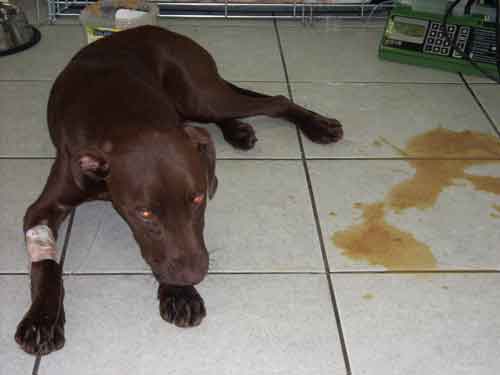Canine Parvovirus
Canine Parvovirus (CPV) is a contagious virus mainly affecting dogs. CPV is highly contagious and spread from one dog to another dog very rapidly. The virus spreads either by direct contact with an infected dog, or direct or indirect contact with their feces, and an infected dog start shedding viruses in feces very early even 3-4 days after exposure that is before the dog show any clinical signs of infection, and continue to shed virus for up to 10 days after recovering from the disease. Heavy amount of the virus found in an infected dog’s feces, so when a healthy dog sniffs or come in contact with an infected dog’s feces, that dog can pick the disease. Apart from this virus can also come into a dog’s surrounding by way of human clothes or shoes.

The CPV infection itself manifest in two different forms, i.e. intestinal and cardiac forms. The most common form is the intestinal form and less common form is the cardiac form, which attacks the heart muscles of fetuses and very young puppies.
Symptom
In intestinal form, dogs that develop the disease show signs of the illness within 3 to 7 days. The important symptoms lethargy, vomiting, fever, and diarrhea (usually bloody). Usually, first sign of CPV is lethargy there after loss of food intake followed by diarrhea and vomiting. There is severe weight loss and affected dog will quickly become dehydrated and weak. Secondary infections usually occur as a result of the weakened immune system. Intestinal walls are severely infected causing blood and protein leak into the intestines leading to anemia and loss of protein.

The cardiac form is less common and affects puppies infected in the uterus or shortly after birth until about 8 weeks of age. The virus attacks the heart muscle and the puppy often dies suddenly or after a brief period of breathing difficulty due to pulmonary edema.
Diagnosis
CPV is diagnosed with a physical examination, especially significant dehydration in association with bloody stools. Biochemical tests, and a special test for the detection of Parvovirus in feces are also present. Low white blood cell levels with dehydration in association with bloody stools is indicative of CPV infection.
Treatment
Since CPV is a viral infection, there is no real cure for it. In CPV treatment is mainly symptomatic focused on releaving the symptoms and preventing secondary bacterial infections. Treatment usually involve Intravenous fluid and nutrition therapy which is crucial in maintaining a dog’s normal body fluid. To control vomiting anti-emetics & antacids and antibiotics to prevent secondary infections. Survival rate depends on how quickly CPV is diagnosed, the age of the dog and how aggressive the treatment is. Survival rate is lower for young puppies, as they do not have fully developed immune system. CPV infected puppies commonly suffer shock and sudden death.
Prevention of CPV in Dogs
CPV infection can be prevented by following the correct protocol for vaccination. With the advice from Veterinarian appropriate vaccination should be performed starting at 7–8 weeks of age, with a booster given every 3–4 weeks until at least 16 weeks of age. High-risk breeds may require a longer initial vaccination period of up to 22 weeks. It is also very important to give anti worm medicines to puppies at least a week prior to vaccination.
|
The content of the articles are accurate and true to the best of the author’s knowledge. It is not meant to substitute for diagnosis, prognosis, treatment, prescription, or formal and individualized advice from a veterinary medical professional. Animals exhibiting signs and symptoms of distress should be seen by a veterinarian immediately. |






Win Myint